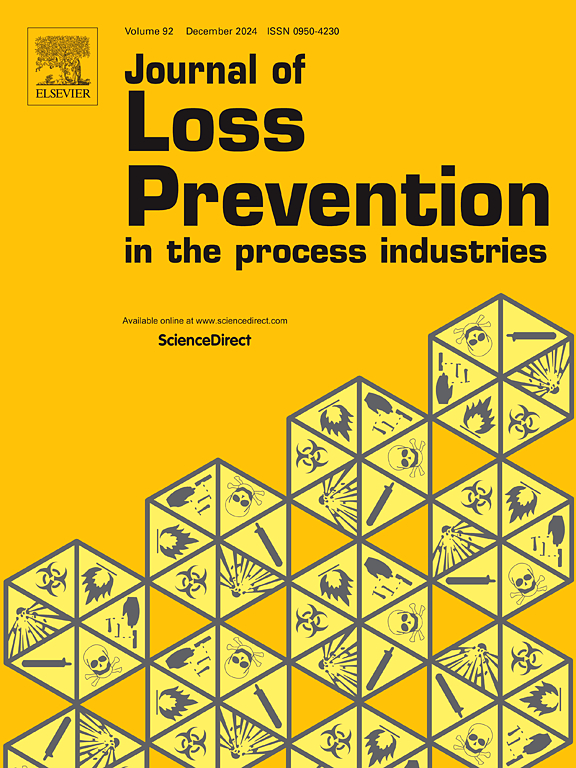障碍电流限制条件下泡沫灭火剂对甲烷/空气爆炸的抑爆效果研究
IF 3.6
3区 工程技术
Q2 ENGINEERING, CHEMICAL
Journal of Loss Prevention in The Process Industries
Pub Date : 2025-04-09
DOI:10.1016/j.jlp.2025.105650
引用次数: 0
摘要
为了研究不同堵塞率障碍物与泡沫灭火剂协同作用对瓦斯爆炸的抑制效果,进行了一系列的实验研究。通过对不同泡沫灭火剂在25%、50%和75%堵塞率下喷雾位置的变化,对不同泡沫灭火剂的防爆性能进行了对比分析。结果表明:由于障碍物对爆炸火焰的节流压缩作用和障碍物对泡沫的滞留阻塞作用,在障碍物下游喷射泡沫灭火剂效果较好,阻塞率较大,喷嘴与障碍物之间的距离较短;当泡沫灭火剂喷射在障碍物上游时,障碍物堵塞率越高,喷嘴到障碍物的距离越远,泡沫抑制区越宽,泡沫灭火剂与爆炸火焰的相互作用越有效,爆炸抑制性能越好。此外,泡沫剂可以吸收爆炸产生的高温,有效降低超压和压力上升的峰值速率。然而,泡沫灭火剂的喷洒位置对爆炸过程中火焰的传播速度有显著影响;当喷射到障碍物上游时,悬浮的泡沫在爆炸火焰中引起更早的湍流,增加了火焰的传播速度。相反,在障碍物下游喷洒可以有效降低火焰的传播速度。本文章由计算机程序翻译,如有差异,请以英文原文为准。
Research on the explosion suppression effect of foam fire extinguishing agents on methane/air explosions under obstacle current limiting conditions
To investigate the suppression effects on gas explosion under the synergistic action of obstacles with varying blockage rates and foam extinguishing agents, a series of experimental studies were conducted. The comparison and analysis of blast mitigation performance were carried out by varying the spray positions of different foam extinguishing agents under blockage rates of 25 %, 50 %, and 75 %. The results indicate that due to the throttling compression effect of obstacles on explosion flames and their retention blockage effect on foam, better blast mitigation is achieved when foam extinguishing agents are sprayed downstream of the obstacles, with greater blockage rates and shorter distances between the spray nozzles and the obstacles. When foamed fire extinguishing agents are sprayed upstream of obstacles, a higher blockage rate of the obstacle and a greater distance from the nozzle to the obstacle result in a broader foam suppression zone, more effective interaction between the foam agents and the explosive flame, and better explosion suppression performance. Additionally, the foam agents can absorb the high temperatures generated by the explosion, effectively reducing overpressure and the peak rate of pressure rise. However, the position where the foam fire extinguishing agents are sprayed significantly influences the rate of flame propagation during the explosion; when sprayed upstream of the obstacle, the suspended foam causes earlier turbulence in the explosive flame, increasing the flame propagation rate. Conversely, spraying downstream of the obstacle can effectively lower the flame propagation rate.
求助全文
通过发布文献求助,成功后即可免费获取论文全文。
去求助
来源期刊
CiteScore
7.20
自引率
14.30%
发文量
226
审稿时长
52 days
期刊介绍:
The broad scope of the journal is process safety. Process safety is defined as the prevention and mitigation of process-related injuries and damage arising from process incidents involving fire, explosion and toxic release. Such undesired events occur in the process industries during the use, storage, manufacture, handling, and transportation of highly hazardous chemicals.

 求助内容:
求助内容: 应助结果提醒方式:
应助结果提醒方式:


